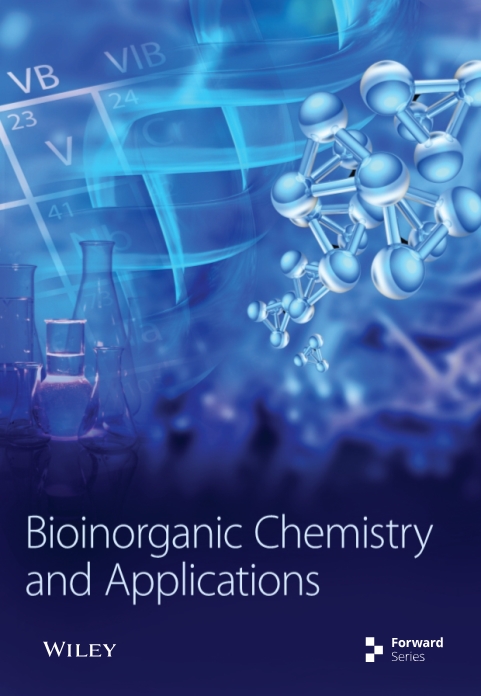具有TiO2/rGO纳米结构的多功能核壳NiFe2O4屏蔽在生物医学和环境中的应用
IF 4.7
3区 化学
Q1 BIOCHEMISTRY & MOLECULAR BIOLOGY
引用次数: 7
摘要
本文通过3个阶段合成了多功能纳米粒子core@shell:以木叶提取物为燃料,微波辐照合成NiFe2O4纳米粒子,溶胶-凝胶法制备core@shell NiFe2O4@TiO2纳米粒子,溶胶-凝胶法制备NiFe2O4@TiO2@rGO纳米粒子。XRD分析证实了立方NiFe2O4尖晶石相和四方TiO2金红石相的存在,Raman光谱分析显示了与还原氧化石墨烯相关的D和G谱带(ID/IG = 1.04)。HRTEM的形貌观察表明,纳米结构由NiFe2O4核组成,SAED证实了NiFe2O4核与随后的TiO2和rGO薄层形成核-壳纳米结构。磁性测量显示出铁磁性行为,其中饱和磁化强度从NiFe2O4的45 emu/g急剧下降到TiO2和rGO非磁性双层涂层后的15 emu/g。制备的多功能core@shell纳米结构具有可调的自热特性:温升和比吸收率分别在ΔT = 3-10°C和SAR = 3-58 W/g范围内。该效果非常接近热疗的阈值温度(45℃),抑制区显示出NTG对各种革兰氏阳性和革兰氏阴性菌株的有效抗菌活性,同时对TC降解具有良好的高效、稳定和可去除的声光催化剂。本文章由计算机程序翻译,如有差异,请以英文原文为准。
Multifunctional Core-Shell NiFe2O4 Shield with TiO2/rGO Nanostructures for Biomedical and Environmental Applications
Multifunctional core@shell nanoparticles have been synthesized in this paper through 3 stages: NiFe2O4 nanoparticles by microwave irradiation using Pedalium murex leaf extract as a fuel, core@shell NiFe2O4@TiO2 nanoparticles by sol-gel, and NiFe2O4@TiO2@rGO by sol-gel using preprepared reduced graphene oxide obtained by modified Hummer's method. XRD analysis confirmed the presence of both cubic NiFe2O4 spinel and tetragonal TiO2 rutile phases, while Raman spectroscopy analysis displays both D and G bands (ID/IG = 1.04) associated with rGO. Morphological observations by HRTEM reveal a core-shell nanostructure formed by NiFe2O4 core as confirmed by SAED with subsequent thin layers of TiO2 and rGO. Magnetic measurements show a ferromagnetic behavior, where the saturation magnetization drops drastically from 45 emu/g for NiFe2O4 to 15 emu/g after TiO2 and rGO nonmagnetic bilayers coating. The as-fabricated multifunctional core@shell nanostructures demonstrate tunable self-heating characteristics: rise of temperature and specific absorption rate in the range of ΔT = 3–10°C and SAR = 3–58 W/g, respectively. This effectiveness is much close to the threshold temperature of hyperthermia (45°C), and the zones of inhibition show the better effective antibacterial activity of NTG against various Gram-positive and Gram-negative bacterial strains besides simultaneous good efficient, stable, and removable sonophotocatalyst toward the TC degradation.
求助全文
通过发布文献求助,成功后即可免费获取论文全文。
去求助
来源期刊

Bioinorganic Chemistry and Applications
化学-生化与分子生物学
CiteScore
7.00
自引率
5.30%
发文量
105
审稿时长
>12 weeks
期刊介绍:
Bioinorganic Chemistry and Applications is primarily devoted to original research papers, but also publishes review articles, editorials, and letter to the editor in the general field of bioinorganic chemistry and its applications. Its scope includes all aspects of bioinorganic chemistry, including bioorganometallic chemistry and applied bioinorganic chemistry. The journal welcomes papers relating to metalloenzymes and model compounds, metal-based drugs, biomaterials, biocatalysis and bioelectronics, metals in biology and medicine, metals toxicology and metals in the environment, metal interactions with biomolecules and spectroscopic applications.
 求助内容:
求助内容: 应助结果提醒方式:
应助结果提醒方式:


